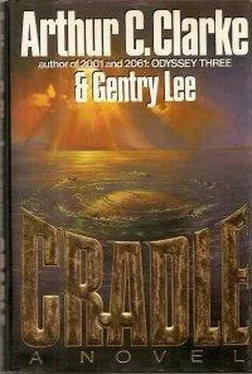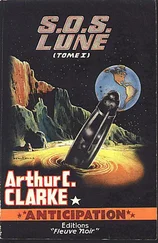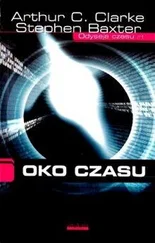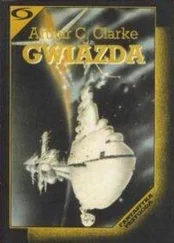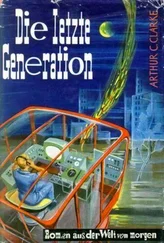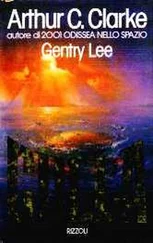Arthur Clarke - Cradle
Здесь есть возможность читать онлайн «Arthur Clarke - Cradle» весь текст электронной книги совершенно бесплатно (целиком полную версию без сокращений). В некоторых случаях можно слушать аудио, скачать через торрент в формате fb2 и присутствует краткое содержание. Год выпуска: 1988, ISBN: 1988, Издательство: Warner Books, Жанр: Фантастика и фэнтези, на английском языке. Описание произведения, (предисловие) а так же отзывы посетителей доступны на портале библиотеки ЛибКат.
- Название:Cradle
- Автор:
- Издательство:Warner Books
- Жанр:
- Год:1988
- ISBN:0-446-51379-2
- Рейтинг книги:4 / 5. Голосов: 1
-
Избранное:Добавить в избранное
- Отзывы:
-
Ваша оценка:
- 80
- 1
- 2
- 3
- 4
- 5
Cradle: краткое содержание, описание и аннотация
Предлагаем к чтению аннотацию, описание, краткое содержание или предисловие (зависит от того, что написал сам автор книги «Cradle»). Если вы не нашли необходимую информацию о книге — напишите в комментариях, мы постараемся отыскать её.
Cradle — читать онлайн бесплатно полную книгу (весь текст) целиком
Ниже представлен текст книги, разбитый по страницам. Система сохранения места последней прочитанной страницы, позволяет с удобством читать онлайн бесплатно книгу «Cradle», без необходимости каждый раз заново искать на чём Вы остановились. Поставьте закладку, и сможете в любой момент перейти на страницу, на которой закончили чтение.
Интервал:
Закладка:
“All right, all right,” Winters said, first looking around the room and then at the digital time printout in the upper left corner of the front wall, “let’s get started. Are you ready Lieutenant Todd?” The other officers sat down at the table. At the last minute another senior staff officer entered the room and took a seat in one of the chairs at the back.
Todd walked around the table to the front of the room, to a podium with a built-in keyboard underneath a small monitor, and eyed Commander Winters. “Yes, sir,” he answered. He activated the computer system in the podium. Todd indicated that he wanted access to the Top Secret Data Base. He then entered a complicated keyed input that was the first pan of a password system. The interactive monitor in the podium next requested the password of the day. Todd’s first attempt was unsuccessful, for he hadn’t remembered the correct spelling. He began to search his pockets for the piece of scrap paper.
The only other keyboard in the room was in the center of the long table where Winters was sitting. While Lieutenant Todd fumbled around at the podium, the commander smiled, entered the password, and then added some code of his own. The center screen came alive in vivid color and showed a stylized woman in a yellow dress, sitting at a piano, while two young boys played checkers behind her. A sense of red flooded forth from the picture. It was a reproduction of one of Matisse’s paintings from his late years in Nice and was magnificently projected at the front of the room. Lieutenant Todd looked startled. A couple of the senior officers laughed.
Winters smiled engagingly. “There are some fairly amazing things that can be done with the resolution power of a 4K-by-4K image and a nearly infinite data base.” There was an awkward silence and then Winters continued. “I guess it’s hopeless to keep trying to expand the education of you young officers on this base. Go on. Continue. I’ve put you already into the Top Secret Data Base and any new input will override the picture.”
Todd composed himself. This man Winters is certainly a queer duck, he thought. The admiral who was the commanding officer of the Key West base had assigned the commander last night to lead this important Panther missile investigation. Winters had an impressive background in missiles and in systems engineering, but whoever heard of starting such a critical meeting by calling a painting up on the screen? Todd now entered 17BROK01 and, after counting the people, the number nine. In a few seconds a machine in the back corner of the room had copies of the presentation collated and stapled for the use of the participants. Todd called his first image (entitled “Introduction and Background”) to the center screen with another touch of the keyboard.
“Yesterday morning,” he began, “a demonstration test for the new Panther missile was conducted over the North Atlantic. The missile was fired at 0700 from an airplane at eighty thousand feet off the coast of Labrador. It was aimed at a target near the Bahamas, one of our old aircraft carriers. After flying a normal ballistic trajectory into the region where the ship was located, the Panther was supposed to activate its terminal guidance that uses the Advanced Pattern Recognition System or APRS. The missile should then have found the aircraft carrier and, using the reaction control jets as its primary control authority, made whatever vernier corrections were necessary to impact the old carrier on the main deck.”
Todd pushed a key on the podium and a line drawing map of the American east coast, including the area from Labrador through Cuba, appeared on the left screen. “The missile was a final test version,” he continued, “in the exact configuration of the production flight vehicle, except for the command test set and the warhead. This was to be the longest test flight yet conducted and was designed to demonstrate thoroughly the new 4.2 version of the software that was recently installed in the APRS. So of course the missile was not armed.”
The lieutenant picked up a light pen from the podium and marked on the small monitor in front of him. His markings were immediately translated to the larger screen behind him so that everyone could easily follow his discussion. “On the screen you all can see the predicted versus actual overflight path of the bird yesterday. Here, roughly ten miles east of Cape Canaveral on what appeared to be a nominal flight, the sequencer turned on the cameras. After a couple of hundred calibration images, sort of a self-test of the APRS, the terminal guidance algorithms were activated as scheduled. As far as we can tell from the realtime telemetry, nothing strange had occurred until this time.”
The right screen now showed a detailed map of south Florida and the Keys that included the target in the Bahamas. The maps on the two flanking screens remained in view during the rest of his presentation but Lieutenant Todd constantly changed the word charts in the middle to keep up with the discussion. “The a priori location of the target, which was where the cameras should first have looked for the aircraft carrier, was here at Eleuthera, in the Bahamas. The search algorithm should have fanned out in a circle from there and, if it had operated properly, found the target in about fifteen seconds. This (Todd pointed toward a dotted line on the more detailed map) should have been the impact trajectory.
“However,” Todd continued dramatically, “based on the telemetry data that we have analyzed to date, it appears that the missile veered sharply westward, toward the coast of Florida, soon after the terminal guidance system was activated. We have only been able to reconstruct its path up to this point, where it was about three miles west of Miami Beach at an altitude of ten thousand feet. After that the telemetry becomes intermittent and erratic. But we do know that all the terminal guidance engines were on at the time we lost complete data. Projecting the total control authority for the missile, the area highlighted here, covering the Everglades, the Keys, and even as far south as Cuba, represents where the bird might have landed.”
Lieutenant Todd paused for a second and Commander Winters, who had been writing down major points in a small notebook during the presentation, immediately jumped in and started taking charge of the meeting. “A couple of questions, Lieutenant, before we proceed,” Winters began in a businesslike manner with an obvious overtone of authority. “First, why was the missile not destroyed soon after it veered off course?”
“We’re not exactly certain, Commander. The command test set and the small ordnance had been installed, of course, specifically for that purpose. The change in the motion of the vehicle was so sudden and so unexpected that we reacted a little slowly at the beginning. By the time we sent the command, it’s possible that we were out of range. All we know is that we never saw an explosion of any kind. We can only assume—”
“We’ll come back to this operational error later,” Winters interrupted him again. Todd blanched at the word “error” and fidgeted behind the podium. “Where would the impact point have been according to the guidance constants active at the time of the last complete telemetry packet? And how long is it going to take us to extract additional information from the intermittent data?”
Lieutenant Todd noted to himself that the commander was sharp. Winters had obviously been associated with anomaly investigations before. Todd then explained that if the active guidance constants had not changed again, the continued firing of the terminal engines would have brought the missile to an impact point about twenty miles south of Key West. “However,” Todd added, “the constants were allowed, by the software, to change every five seconds. And they had changed in two of the last five internal data updates. So it’s unlikely they stayed the same as they were when our complete telemetry terminated. Unfortunately, although all the constants—even the future predicted ones that are being calculated by the APRS-are stored in the onboard computer, because of bandwidth limitations we only transmit the active constants with the realtime telemetry. We are now going through the dropout data manually to see if we can find out anything more about the constants.”
Читать дальшеИнтервал:
Закладка:
Похожие книги на «Cradle»
Представляем Вашему вниманию похожие книги на «Cradle» списком для выбора. Мы отобрали схожую по названию и смыслу литературу в надежде предоставить читателям больше вариантов отыскать новые, интересные, ещё непрочитанные произведения.
Обсуждение, отзывы о книге «Cradle» и просто собственные мнения читателей. Оставьте ваши комментарии, напишите, что Вы думаете о произведении, его смысле или главных героях. Укажите что конкретно понравилось, а что нет, и почему Вы так считаете.
